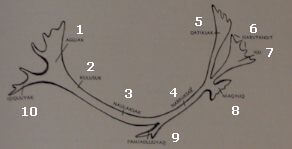Inuit Culture - The Antlers of the Caribou
By: Fr. Georges Lorson OMI - 1966



The Antlers of the Caribou
If the Inuktituk vocabulary is lacking in abstract terms, it is also very rich in concrete terms. Take the example of the word “carry”. In English, the word “carry” is used whether the object is placed on the head, on the back, on the shoulder, in the hand or on the forearm. In Inuktituk, there is a different word for each possibility.
The same is true of the different parts of game animals used by the Inuit as raw material. The other day, I gave a very old grandfather a set of caribou antlers and asked him to turn it into the panoply of weapons and tools used in days gone by for seal hunting. The old man started rattling of the names of the different sections of the horn he was holding. Seeing my interest, he started pointing of the specific uses to which every centimeter of this precious material was put.
Description in Inuktituk:

- AGGIAK
- KULUSUK
- NAULAKSAK
- NARRUKSAK
- QATIKSAK
- ISARUTANGIT
- IGU
- NIAQINIQ
- PAMIATLUUYAQ
- IQIQUUYAK
The horn itself is called nagjuk, while the base of the horn, fuse to the scull, is niaqiniq (from niaqu - head). Each autumn, this part detaches itself: the male caribou looses its antlers while the adult female which, unlike the doe, has horns, even though smaller than those of the male, keeps her headdress. There is, between the arctic coast and Garry Lake, a large plain called Nagjulik, from the word for antlers which are found in great numbers there. It is also said that one can see many skeletons of males which locked antlers while fighting and were unable to disengage themselves. The niaqiniq is used to fashion the handle for the saggut, the long stick used to measure the thickness of the snow bank or to find a cache made in the summer and now covered with the snow.
One of the two horns has a voluminous appendage extending over the muzzle: this is the igu with its tines, isarutangit. According to some authorities, this appendage helps the animal to guide himself and stay on a chosen path. The thinnest part will be used to make pana or snowknife. The vertical part will be turn into the ipuligak or handle of the native shovel.
Just above the igu is the gatiksak. At the base of this branch will be bored the hole of the narrursurvik which, in turn, will be used to straighten the pieces used in fashioning of bow, arrows and harpoons. The straightening process is very delicate work and calls for a lot of patience. There is the story in this connection, involving Nakasuk, whose violent temper was well known. He was deeply engrossed by this task, comfortably seated in his igloo, when his son in law, well known for his practical jokes, came in and sat near him. Even though he knew that his father in law was in no mood for humor, his fondness of practical jokes got the better of him. Measuring the distance between his seat and the igloo entrance with his eyes, he waited for the moment when Nakasuk, having placed the horn in the narrursurvik, was slowly and gently bending it forward: he suddenly clapped his hands and screamed at the top of his lungs. Nakasuk was startled and the horn broke. Furious, he grabbed his harpoon and threw it at his son in low: but, too late; the joker has already started out the door laughing and the harpoon landed a few inches from his foot.
The katiksak is also used, by cutting along its length and following the curve, to make the saggutauyuq, the shaft used to explore the snow-covered breathing holes for seals in the ice. There is a still a fairly large piece left and, more often than not, it will become ipuligak or handle, or the qitirak of the Inuit shovel.
Still using the main branch, we come to the narruksak, so called because it must be delicately straightened to give it the shape of the bow or the shaft of arrows.
A little further down the main branch is small tine, the pamiatluuyaq, which derives its name from its similarity to a small tale. There is enough substance here to complete the harpoon, unaq, or an awl, pitiksirak.
The main branch then becomes the naulaksak, because from it will be fashioned the nauligak or fish spear. The upper part of the naulaksak is called kulusuk.
Then there is the irqiquuyaq, that which resembles the little finger. The small fork will become the support for the corner of the dryer, above the oil lamp, and will then be called aak.
At the very tip is found aggiak, that which resembles a hand. After all, the housewife is entitled to one part of this raw material. Planted in the igloo wall, close at hand, near the oil lamp, in the housewife's exclusive domain, the kitchen utensils will be hung from it. It has become the pauguak.
I forgot to mention that caribou antlers have different shapes and sizes depending on age and sex. In order to obtain all the above-mentioned articles one would have to use the antlers of a pangniq, an adult male. In our Pelly Bay mission, we used to have superb set which supported the altar in our small chapel. The horns measured 52 and 46 inches respectively. With such a headdress, the owner must have enjoyed great success with members of the opposite sex and undoubtedly intimidated more than one opponent.

